University Report: Evaluating Financial Performance of Companies
VerifiedAdded on 2023/04/07
|63
|10828
|385
Report
AI Summary
This report presents a comprehensive evaluation of the financial performance of car manufacturing companies in the UK and US, focusing on the period from 2013 to 2017. The research employs a positivist philosophy, descriptive research design, and a deductive approach to analyze the financial health of leading companies. The study examines profitability, liquidity, efficiency, and solvency ratios of selected firms, including Aston Martin, Jaguar, Rolls Royce (UK), and General Motors, Fiat Chrysler, and Tesla Inc (US). Furthermore, the report applies financial models such as Market Value Added (MVA) and Economic Value Added (EVA) to forecast future growth. The findings highlight competitive advantages in different areas for both the UK and US car manufacturing sectors, providing valuable insights into their financial positions and future prospects. The report concludes with recommendations and acknowledges the limitations and scope for future research.
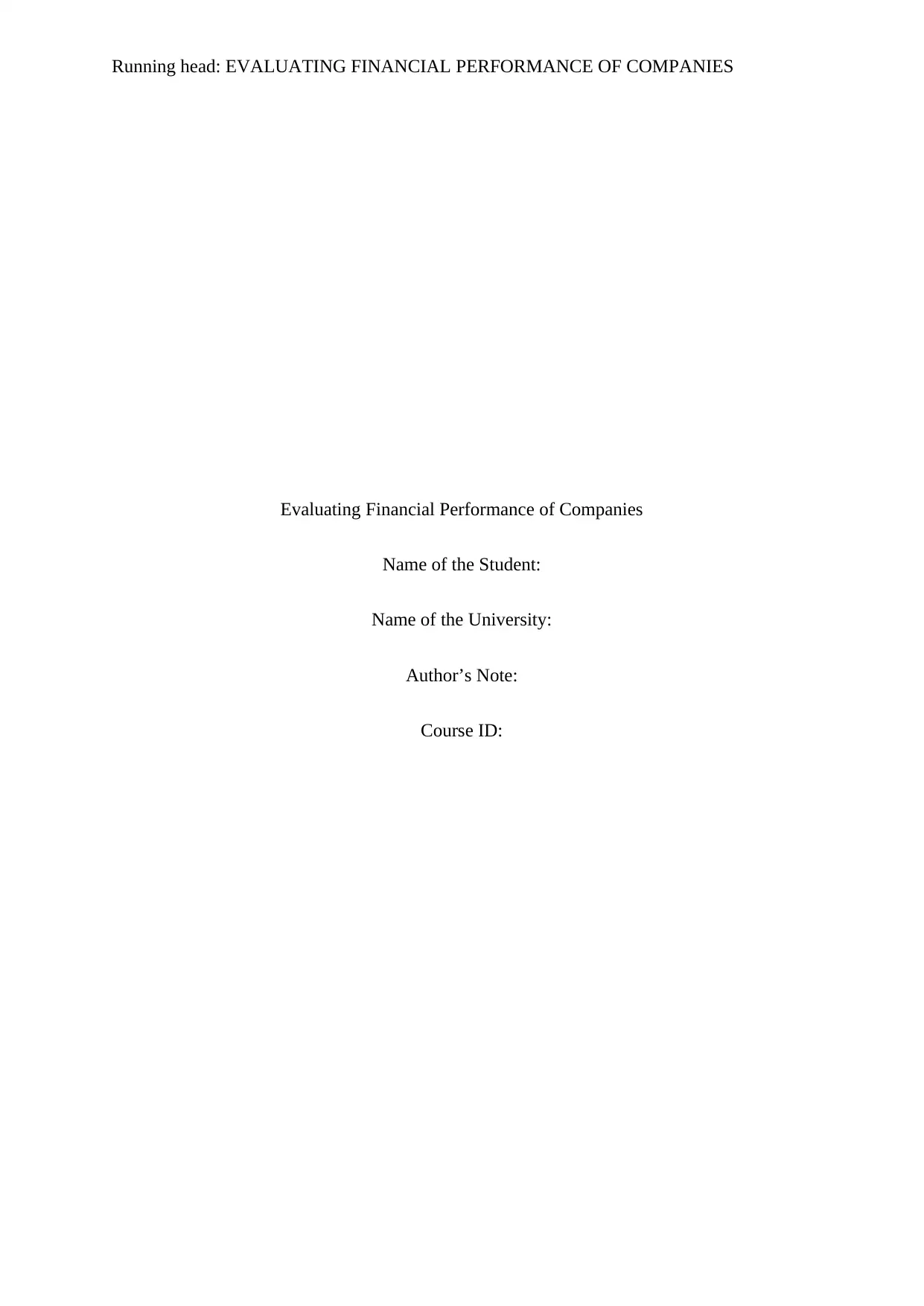
Running head: EVALUATING FINANCIAL PERFORMANCE OF COMPANIES
Evaluating Financial Performance of Companies
Name of the Student:
Name of the University:
Author’s Note:
Course ID:
Evaluating Financial Performance of Companies
Name of the Student:
Name of the University:
Author’s Note:
Course ID:
Paraphrase This Document
Need a fresh take? Get an instant paraphrase of this document with our AI Paraphraser
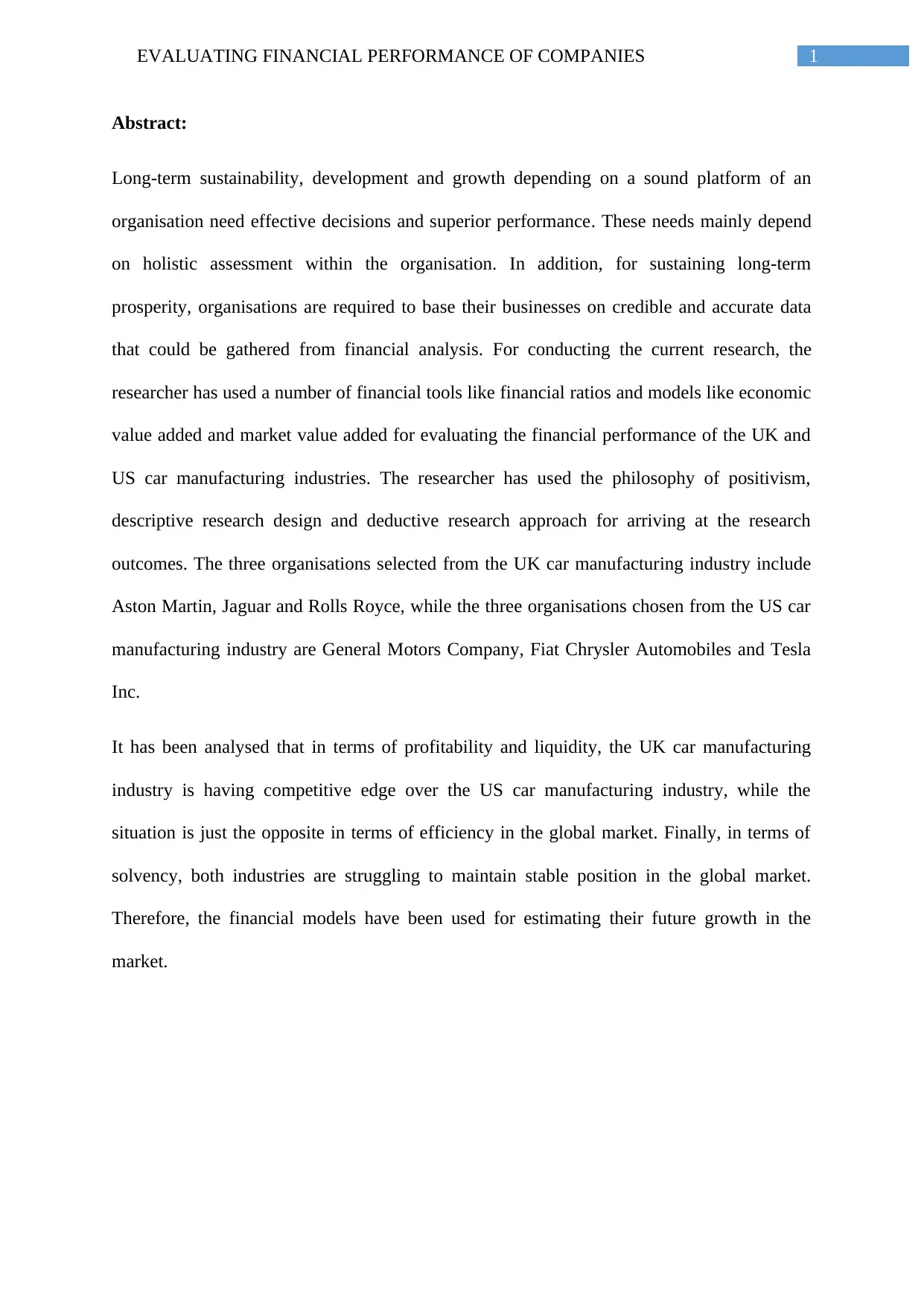
1EVALUATING FINANCIAL PERFORMANCE OF COMPANIES
Abstract:
Long-term sustainability, development and growth depending on a sound platform of an
organisation need effective decisions and superior performance. These needs mainly depend
on holistic assessment within the organisation. In addition, for sustaining long-term
prosperity, organisations are required to base their businesses on credible and accurate data
that could be gathered from financial analysis. For conducting the current research, the
researcher has used a number of financial tools like financial ratios and models like economic
value added and market value added for evaluating the financial performance of the UK and
US car manufacturing industries. The researcher has used the philosophy of positivism,
descriptive research design and deductive research approach for arriving at the research
outcomes. The three organisations selected from the UK car manufacturing industry include
Aston Martin, Jaguar and Rolls Royce, while the three organisations chosen from the US car
manufacturing industry are General Motors Company, Fiat Chrysler Automobiles and Tesla
Inc.
It has been analysed that in terms of profitability and liquidity, the UK car manufacturing
industry is having competitive edge over the US car manufacturing industry, while the
situation is just the opposite in terms of efficiency in the global market. Finally, in terms of
solvency, both industries are struggling to maintain stable position in the global market.
Therefore, the financial models have been used for estimating their future growth in the
market.
Abstract:
Long-term sustainability, development and growth depending on a sound platform of an
organisation need effective decisions and superior performance. These needs mainly depend
on holistic assessment within the organisation. In addition, for sustaining long-term
prosperity, organisations are required to base their businesses on credible and accurate data
that could be gathered from financial analysis. For conducting the current research, the
researcher has used a number of financial tools like financial ratios and models like economic
value added and market value added for evaluating the financial performance of the UK and
US car manufacturing industries. The researcher has used the philosophy of positivism,
descriptive research design and deductive research approach for arriving at the research
outcomes. The three organisations selected from the UK car manufacturing industry include
Aston Martin, Jaguar and Rolls Royce, while the three organisations chosen from the US car
manufacturing industry are General Motors Company, Fiat Chrysler Automobiles and Tesla
Inc.
It has been analysed that in terms of profitability and liquidity, the UK car manufacturing
industry is having competitive edge over the US car manufacturing industry, while the
situation is just the opposite in terms of efficiency in the global market. Finally, in terms of
solvency, both industries are struggling to maintain stable position in the global market.
Therefore, the financial models have been used for estimating their future growth in the
market.
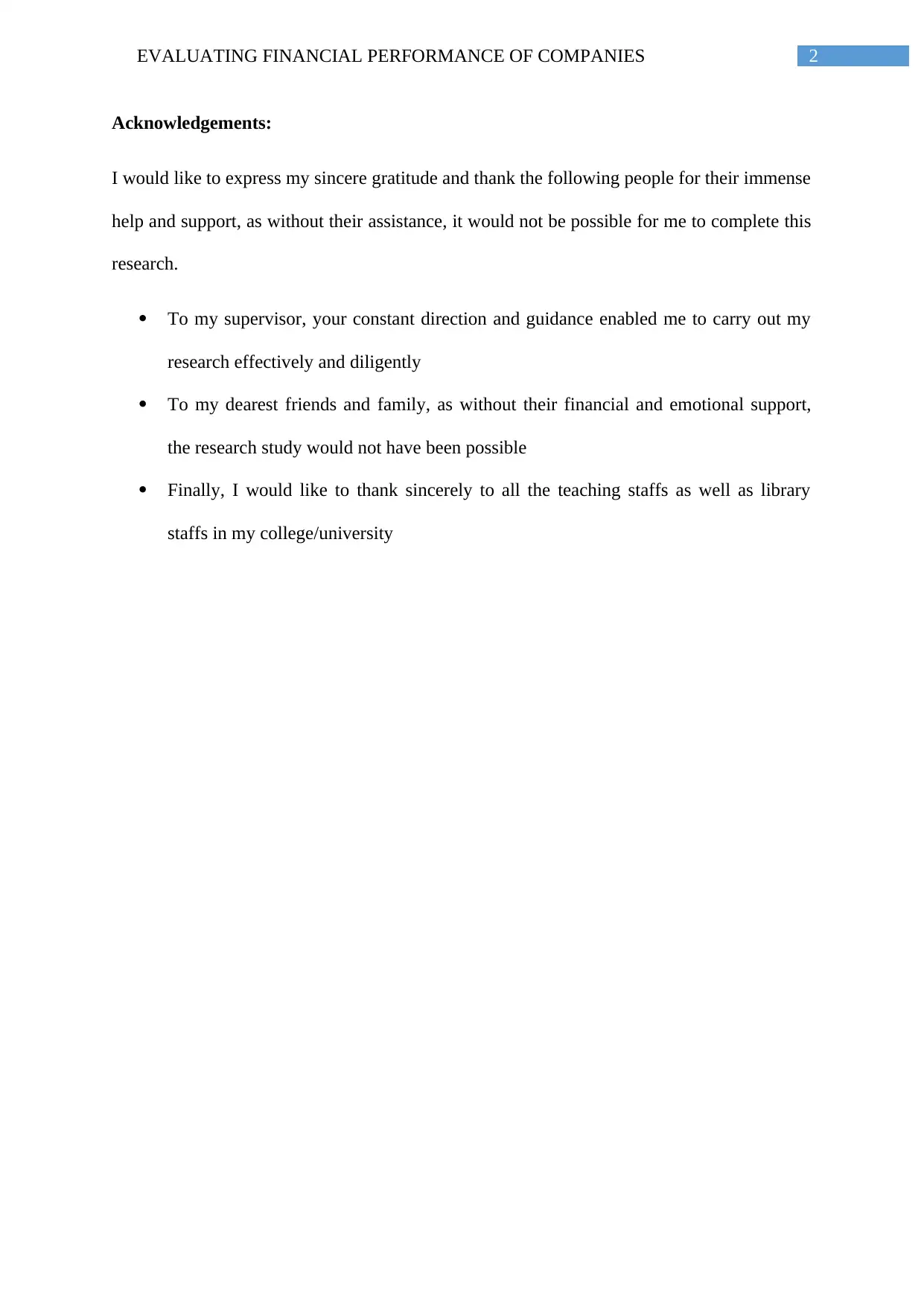
2EVALUATING FINANCIAL PERFORMANCE OF COMPANIES
Acknowledgements:
I would like to express my sincere gratitude and thank the following people for their immense
help and support, as without their assistance, it would not be possible for me to complete this
research.
To my supervisor, your constant direction and guidance enabled me to carry out my
research effectively and diligently
To my dearest friends and family, as without their financial and emotional support,
the research study would not have been possible
Finally, I would like to thank sincerely to all the teaching staffs as well as library
staffs in my college/university
Acknowledgements:
I would like to express my sincere gratitude and thank the following people for their immense
help and support, as without their assistance, it would not be possible for me to complete this
research.
To my supervisor, your constant direction and guidance enabled me to carry out my
research effectively and diligently
To my dearest friends and family, as without their financial and emotional support,
the research study would not have been possible
Finally, I would like to thank sincerely to all the teaching staffs as well as library
staffs in my college/university
⊘ This is a preview!⊘
Do you want full access?
Subscribe today to unlock all pages.

Trusted by 1+ million students worldwide
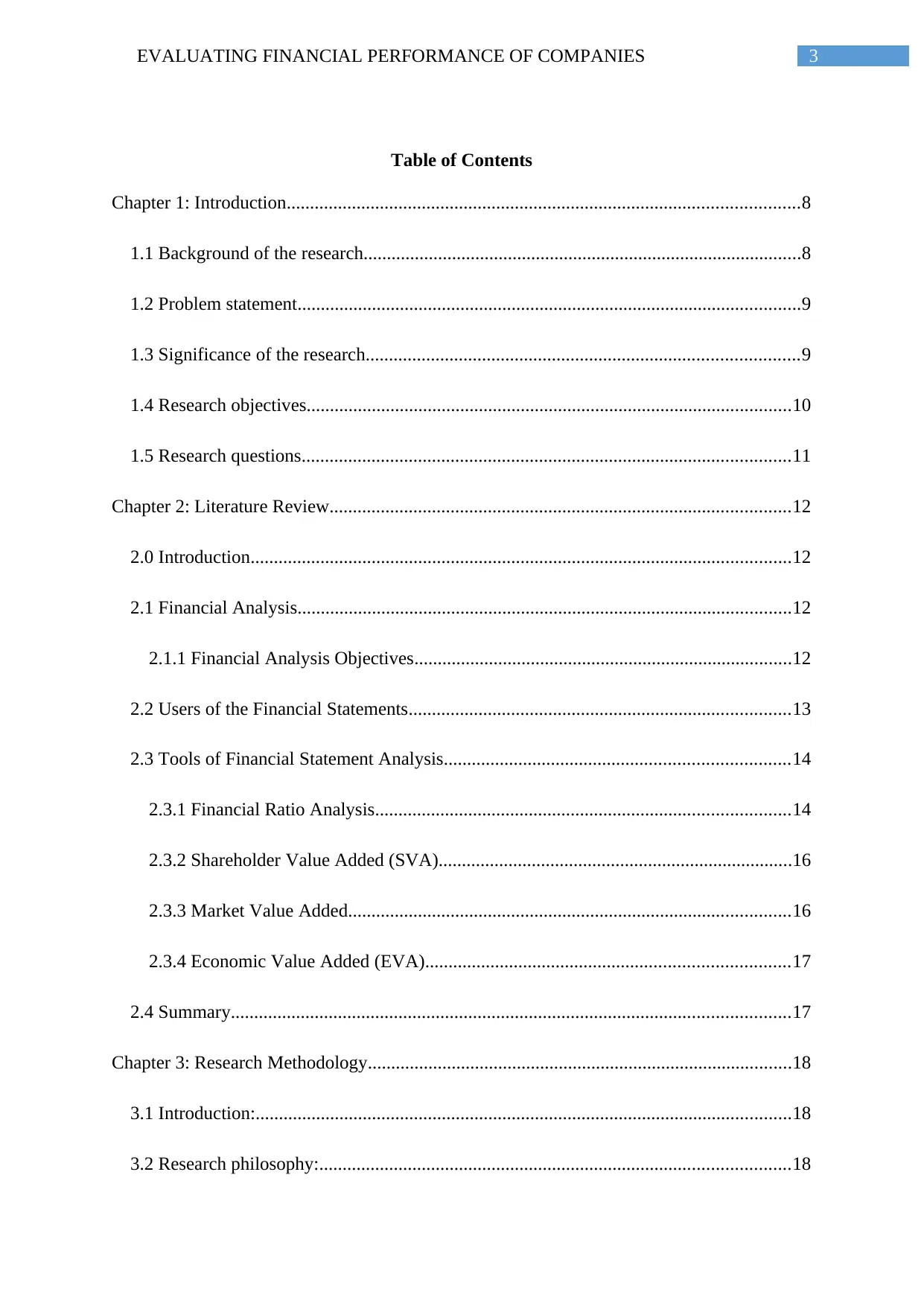
3EVALUATING FINANCIAL PERFORMANCE OF COMPANIES
Table of Contents
Chapter 1: Introduction..............................................................................................................8
1.1 Background of the research..............................................................................................8
1.2 Problem statement............................................................................................................9
1.3 Significance of the research.............................................................................................9
1.4 Research objectives........................................................................................................10
1.5 Research questions.........................................................................................................11
Chapter 2: Literature Review...................................................................................................12
2.0 Introduction....................................................................................................................12
2.1 Financial Analysis..........................................................................................................12
2.1.1 Financial Analysis Objectives.................................................................................12
2.2 Users of the Financial Statements..................................................................................13
2.3 Tools of Financial Statement Analysis..........................................................................14
2.3.1 Financial Ratio Analysis.........................................................................................14
2.3.2 Shareholder Value Added (SVA)............................................................................16
2.3.3 Market Value Added...............................................................................................16
2.3.4 Economic Value Added (EVA)..............................................................................17
2.4 Summary........................................................................................................................17
Chapter 3: Research Methodology...........................................................................................18
3.1 Introduction:...................................................................................................................18
3.2 Research philosophy:.....................................................................................................18
Table of Contents
Chapter 1: Introduction..............................................................................................................8
1.1 Background of the research..............................................................................................8
1.2 Problem statement............................................................................................................9
1.3 Significance of the research.............................................................................................9
1.4 Research objectives........................................................................................................10
1.5 Research questions.........................................................................................................11
Chapter 2: Literature Review...................................................................................................12
2.0 Introduction....................................................................................................................12
2.1 Financial Analysis..........................................................................................................12
2.1.1 Financial Analysis Objectives.................................................................................12
2.2 Users of the Financial Statements..................................................................................13
2.3 Tools of Financial Statement Analysis..........................................................................14
2.3.1 Financial Ratio Analysis.........................................................................................14
2.3.2 Shareholder Value Added (SVA)............................................................................16
2.3.3 Market Value Added...............................................................................................16
2.3.4 Economic Value Added (EVA)..............................................................................17
2.4 Summary........................................................................................................................17
Chapter 3: Research Methodology...........................................................................................18
3.1 Introduction:...................................................................................................................18
3.2 Research philosophy:.....................................................................................................18
Paraphrase This Document
Need a fresh take? Get an instant paraphrase of this document with our AI Paraphraser

4EVALUATING FINANCIAL PERFORMANCE OF COMPANIES
3.3 Research approach:........................................................................................................18
3.4 Research design:.............................................................................................................19
3.5 Sampling and sample size:.............................................................................................19
3.6 Data collection and analysis:..........................................................................................20
3.7 Timeframe of the research:............................................................................................20
3.8 Summary:.......................................................................................................................21
Chapter 4: Data Analysis.........................................................................................................22
4.1 Introduction:...................................................................................................................22
4.2 Financial analysis of the car manufacturing companies in UK and USA:.....................22
4.2.1 Profitability analysis:..............................................................................................22
4.2.2 Liquidity analysis:...................................................................................................29
4.2.3 Efficiency analysis:.................................................................................................34
4.2.4 Solvency analysis:...................................................................................................41
4.3 Application of financial models in the selected car manufacturing organisations:.......48
4.4 Summary:.......................................................................................................................52
Chapter 5: Conclusion and Recommendations........................................................................53
5.1 Conclusion:....................................................................................................................53
5.2 Linking with the research objectives:............................................................................53
5.3 Recommendations:.........................................................................................................55
5.4 Limitations and future scope of the research:................................................................55
References and Bibliographies:................................................................................................56
3.3 Research approach:........................................................................................................18
3.4 Research design:.............................................................................................................19
3.5 Sampling and sample size:.............................................................................................19
3.6 Data collection and analysis:..........................................................................................20
3.7 Timeframe of the research:............................................................................................20
3.8 Summary:.......................................................................................................................21
Chapter 4: Data Analysis.........................................................................................................22
4.1 Introduction:...................................................................................................................22
4.2 Financial analysis of the car manufacturing companies in UK and USA:.....................22
4.2.1 Profitability analysis:..............................................................................................22
4.2.2 Liquidity analysis:...................................................................................................29
4.2.3 Efficiency analysis:.................................................................................................34
4.2.4 Solvency analysis:...................................................................................................41
4.3 Application of financial models in the selected car manufacturing organisations:.......48
4.4 Summary:.......................................................................................................................52
Chapter 5: Conclusion and Recommendations........................................................................53
5.1 Conclusion:....................................................................................................................53
5.2 Linking with the research objectives:............................................................................53
5.3 Recommendations:.........................................................................................................55
5.4 Limitations and future scope of the research:................................................................55
References and Bibliographies:................................................................................................56
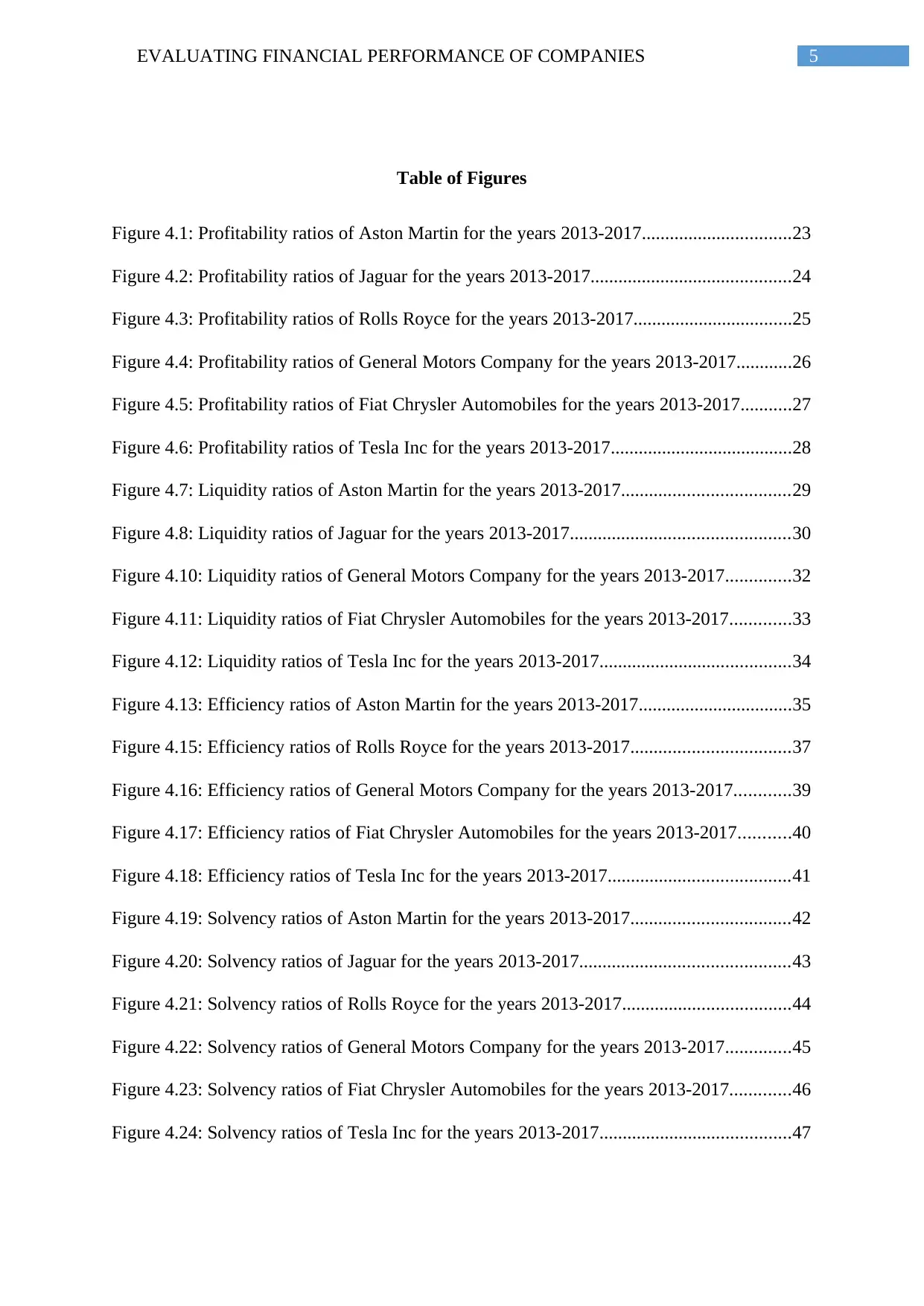
5EVALUATING FINANCIAL PERFORMANCE OF COMPANIES
Table of Figures
Figure 4.1: Profitability ratios of Aston Martin for the years 2013-2017................................23
Figure 4.2: Profitability ratios of Jaguar for the years 2013-2017...........................................24
Figure 4.3: Profitability ratios of Rolls Royce for the years 2013-2017..................................25
Figure 4.4: Profitability ratios of General Motors Company for the years 2013-2017............26
Figure 4.5: Profitability ratios of Fiat Chrysler Automobiles for the years 2013-2017...........27
Figure 4.6: Profitability ratios of Tesla Inc for the years 2013-2017.......................................28
Figure 4.7: Liquidity ratios of Aston Martin for the years 2013-2017....................................29
Figure 4.8: Liquidity ratios of Jaguar for the years 2013-2017...............................................30
Figure 4.10: Liquidity ratios of General Motors Company for the years 2013-2017..............32
Figure 4.11: Liquidity ratios of Fiat Chrysler Automobiles for the years 2013-2017.............33
Figure 4.12: Liquidity ratios of Tesla Inc for the years 2013-2017.........................................34
Figure 4.13: Efficiency ratios of Aston Martin for the years 2013-2017.................................35
Figure 4.15: Efficiency ratios of Rolls Royce for the years 2013-2017..................................37
Figure 4.16: Efficiency ratios of General Motors Company for the years 2013-2017............39
Figure 4.17: Efficiency ratios of Fiat Chrysler Automobiles for the years 2013-2017...........40
Figure 4.18: Efficiency ratios of Tesla Inc for the years 2013-2017.......................................41
Figure 4.19: Solvency ratios of Aston Martin for the years 2013-2017..................................42
Figure 4.20: Solvency ratios of Jaguar for the years 2013-2017.............................................43
Figure 4.21: Solvency ratios of Rolls Royce for the years 2013-2017....................................44
Figure 4.22: Solvency ratios of General Motors Company for the years 2013-2017..............45
Figure 4.23: Solvency ratios of Fiat Chrysler Automobiles for the years 2013-2017.............46
Figure 4.24: Solvency ratios of Tesla Inc for the years 2013-2017.........................................47
Table of Figures
Figure 4.1: Profitability ratios of Aston Martin for the years 2013-2017................................23
Figure 4.2: Profitability ratios of Jaguar for the years 2013-2017...........................................24
Figure 4.3: Profitability ratios of Rolls Royce for the years 2013-2017..................................25
Figure 4.4: Profitability ratios of General Motors Company for the years 2013-2017............26
Figure 4.5: Profitability ratios of Fiat Chrysler Automobiles for the years 2013-2017...........27
Figure 4.6: Profitability ratios of Tesla Inc for the years 2013-2017.......................................28
Figure 4.7: Liquidity ratios of Aston Martin for the years 2013-2017....................................29
Figure 4.8: Liquidity ratios of Jaguar for the years 2013-2017...............................................30
Figure 4.10: Liquidity ratios of General Motors Company for the years 2013-2017..............32
Figure 4.11: Liquidity ratios of Fiat Chrysler Automobiles for the years 2013-2017.............33
Figure 4.12: Liquidity ratios of Tesla Inc for the years 2013-2017.........................................34
Figure 4.13: Efficiency ratios of Aston Martin for the years 2013-2017.................................35
Figure 4.15: Efficiency ratios of Rolls Royce for the years 2013-2017..................................37
Figure 4.16: Efficiency ratios of General Motors Company for the years 2013-2017............39
Figure 4.17: Efficiency ratios of Fiat Chrysler Automobiles for the years 2013-2017...........40
Figure 4.18: Efficiency ratios of Tesla Inc for the years 2013-2017.......................................41
Figure 4.19: Solvency ratios of Aston Martin for the years 2013-2017..................................42
Figure 4.20: Solvency ratios of Jaguar for the years 2013-2017.............................................43
Figure 4.21: Solvency ratios of Rolls Royce for the years 2013-2017....................................44
Figure 4.22: Solvency ratios of General Motors Company for the years 2013-2017..............45
Figure 4.23: Solvency ratios of Fiat Chrysler Automobiles for the years 2013-2017.............46
Figure 4.24: Solvency ratios of Tesla Inc for the years 2013-2017.........................................47
⊘ This is a preview!⊘
Do you want full access?
Subscribe today to unlock all pages.

Trusted by 1+ million students worldwide

6EVALUATING FINANCIAL PERFORMANCE OF COMPANIES
Paraphrase This Document
Need a fresh take? Get an instant paraphrase of this document with our AI Paraphraser

7EVALUATING FINANCIAL PERFORMANCE OF COMPANIES
Table of Tables
Table 3.1: Timeframe of the research......................................................................................21
Table 4.1: Profitability ratios of Aston Martin for the years 2013-2017.................................22
Table 4.2: Profitability ratios of Jaguar for the years 2013-2017............................................23
Table 4.3: Profitability ratios of Rolls Royce for the years 2013-2017...................................24
Table 4.4: Profitability ratios of General Motors Company for the years 2013-2017.............26
Table 4.5: Profitability ratios of Fiat Chrysler Automobiles for the years 2013-2017............27
Table 4.6: Profitability ratios of Tesla Inc for the years 2013-2017........................................27
Table 4.7: Liquidity ratios of Aston Martin for the years 2013-2017......................................29
Table 4.8: Liquidity ratios of Jaguar for the years 2013-2017.................................................30
Table 4.9: Liquidity ratios of Rolls Royce for the years 2013-2017.......................................30
Figure 4.9: Liquidity ratios of Rolls Royce for the years 2013-2017......................................31
Table 4.10: Liquidity ratios of General Motors Company for the years 2013-2017...............32
Table 4.11: Liquidity ratios of Fiat Chrysler Automobiles for the years 2013-2017..............32
Table 4.12: Liquidity ratios of Tesla Inc for the years 2013-2017..........................................33
Table 4.13: Efficiency ratios of Aston Martin for the years 2013-2017..................................35
Table 4.14: Efficiency ratios of Jaguar for the years 2013-2017.............................................36
Figure 4.14: Efficiency ratios of Jaguar for the years 2013-2017............................................36
Table 4.15: Efficiency ratios of Rolls Royce for the years 2013-2017....................................37
Table 4.16: Efficiency ratios of General Motors Company for the years 2013-2017..............38
Table 4.17: Efficiency ratios of Fiat Chrysler Automobiles for the years 2013-2017.............39
Table 4.18: Efficiency ratios of Tesla Inc for the years 2013-2017.........................................40
Table 4.19: Solvency ratios of Aston Martin for the years 2013-2017....................................42
Table 4.20: Solvency ratios of Jaguar for the years 2013-2017...............................................42
Table 4.21: Solvency ratios of Rolls Royce for the years 2013-2017.....................................43
Table of Tables
Table 3.1: Timeframe of the research......................................................................................21
Table 4.1: Profitability ratios of Aston Martin for the years 2013-2017.................................22
Table 4.2: Profitability ratios of Jaguar for the years 2013-2017............................................23
Table 4.3: Profitability ratios of Rolls Royce for the years 2013-2017...................................24
Table 4.4: Profitability ratios of General Motors Company for the years 2013-2017.............26
Table 4.5: Profitability ratios of Fiat Chrysler Automobiles for the years 2013-2017............27
Table 4.6: Profitability ratios of Tesla Inc for the years 2013-2017........................................27
Table 4.7: Liquidity ratios of Aston Martin for the years 2013-2017......................................29
Table 4.8: Liquidity ratios of Jaguar for the years 2013-2017.................................................30
Table 4.9: Liquidity ratios of Rolls Royce for the years 2013-2017.......................................30
Figure 4.9: Liquidity ratios of Rolls Royce for the years 2013-2017......................................31
Table 4.10: Liquidity ratios of General Motors Company for the years 2013-2017...............32
Table 4.11: Liquidity ratios of Fiat Chrysler Automobiles for the years 2013-2017..............32
Table 4.12: Liquidity ratios of Tesla Inc for the years 2013-2017..........................................33
Table 4.13: Efficiency ratios of Aston Martin for the years 2013-2017..................................35
Table 4.14: Efficiency ratios of Jaguar for the years 2013-2017.............................................36
Figure 4.14: Efficiency ratios of Jaguar for the years 2013-2017............................................36
Table 4.15: Efficiency ratios of Rolls Royce for the years 2013-2017....................................37
Table 4.16: Efficiency ratios of General Motors Company for the years 2013-2017..............38
Table 4.17: Efficiency ratios of Fiat Chrysler Automobiles for the years 2013-2017.............39
Table 4.18: Efficiency ratios of Tesla Inc for the years 2013-2017.........................................40
Table 4.19: Solvency ratios of Aston Martin for the years 2013-2017....................................42
Table 4.20: Solvency ratios of Jaguar for the years 2013-2017...............................................42
Table 4.21: Solvency ratios of Rolls Royce for the years 2013-2017.....................................43

8EVALUATING FINANCIAL PERFORMANCE OF COMPANIES
Table 4.22: Solvency ratios of General Motors Company for the years 2013-2017...............45
Table 4.23: Solvency ratios of Fiat Chrysler Automobiles for the years 2013-2017..............45
Table 4.24: Solvency ratios of Tesla Inc for the years 2013-2017..........................................46
Table 4.25: MVA Table ofUK Car Manufacturing Firms.......................................................48
Table 4.26: MVA Table ofUS Car Manufacturing Firms........................................................49
Table 4.27: EVA Table ofUK Car Manufacturing Firms........................................................50
Table 4.28: EVA Table ofUS Car Manufacturing Firms.........................................................51
Table 4.22: Solvency ratios of General Motors Company for the years 2013-2017...............45
Table 4.23: Solvency ratios of Fiat Chrysler Automobiles for the years 2013-2017..............45
Table 4.24: Solvency ratios of Tesla Inc for the years 2013-2017..........................................46
Table 4.25: MVA Table ofUK Car Manufacturing Firms.......................................................48
Table 4.26: MVA Table ofUS Car Manufacturing Firms........................................................49
Table 4.27: EVA Table ofUK Car Manufacturing Firms........................................................50
Table 4.28: EVA Table ofUS Car Manufacturing Firms.........................................................51
⊘ This is a preview!⊘
Do you want full access?
Subscribe today to unlock all pages.

Trusted by 1+ million students worldwide
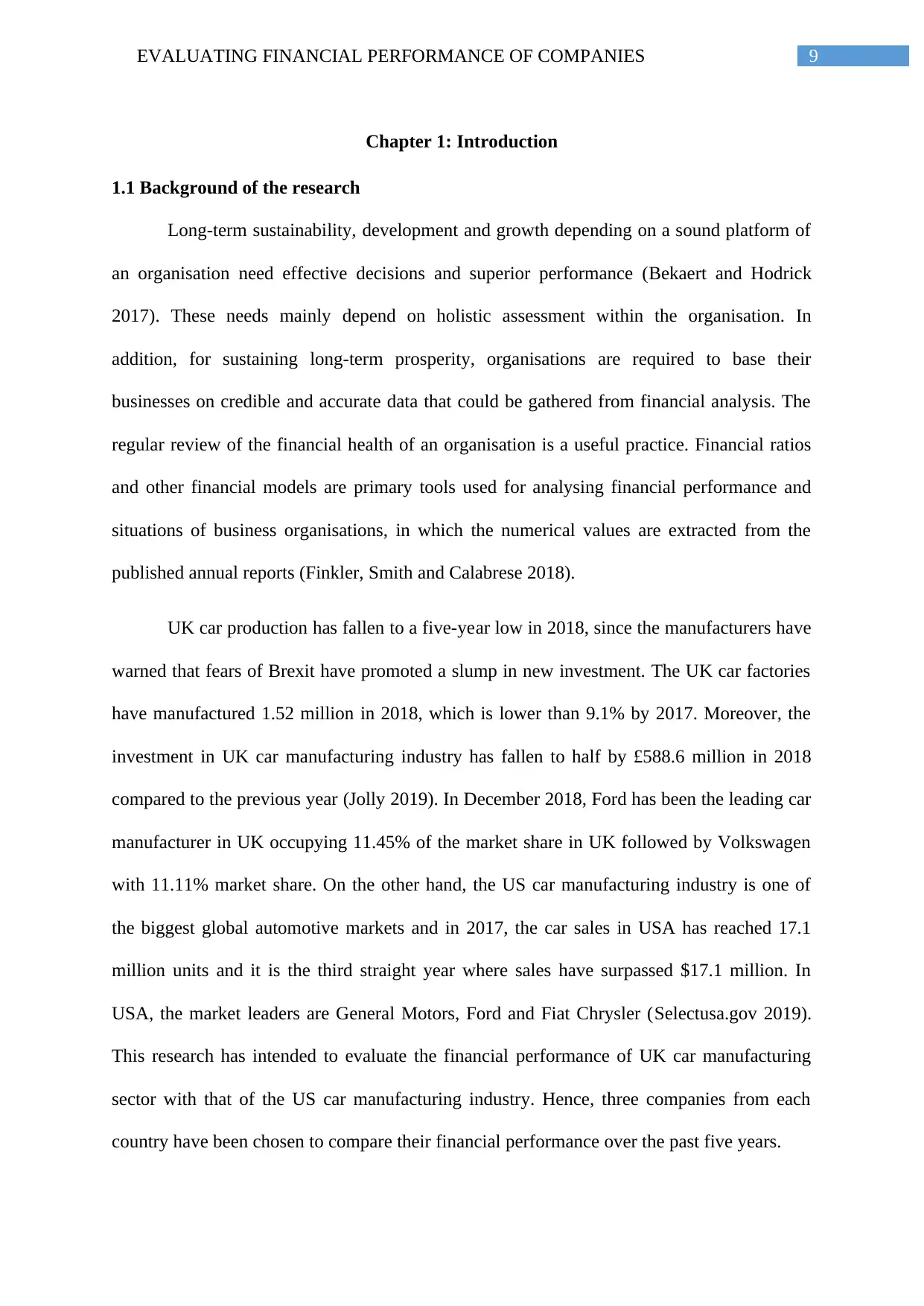
9EVALUATING FINANCIAL PERFORMANCE OF COMPANIES
Chapter 1: Introduction
1.1 Background of the research
Long-term sustainability, development and growth depending on a sound platform of
an organisation need effective decisions and superior performance (Bekaert and Hodrick
2017). These needs mainly depend on holistic assessment within the organisation. In
addition, for sustaining long-term prosperity, organisations are required to base their
businesses on credible and accurate data that could be gathered from financial analysis. The
regular review of the financial health of an organisation is a useful practice. Financial ratios
and other financial models are primary tools used for analysing financial performance and
situations of business organisations, in which the numerical values are extracted from the
published annual reports (Finkler, Smith and Calabrese 2018).
UK car production has fallen to a five-year low in 2018, since the manufacturers have
warned that fears of Brexit have promoted a slump in new investment. The UK car factories
have manufactured 1.52 million in 2018, which is lower than 9.1% by 2017. Moreover, the
investment in UK car manufacturing industry has fallen to half by £588.6 million in 2018
compared to the previous year (Jolly 2019). In December 2018, Ford has been the leading car
manufacturer in UK occupying 11.45% of the market share in UK followed by Volkswagen
with 11.11% market share. On the other hand, the US car manufacturing industry is one of
the biggest global automotive markets and in 2017, the car sales in USA has reached 17.1
million units and it is the third straight year where sales have surpassed $17.1 million. In
USA, the market leaders are General Motors, Ford and Fiat Chrysler (Selectusa.gov 2019).
This research has intended to evaluate the financial performance of UK car manufacturing
sector with that of the US car manufacturing industry. Hence, three companies from each
country have been chosen to compare their financial performance over the past five years.
Chapter 1: Introduction
1.1 Background of the research
Long-term sustainability, development and growth depending on a sound platform of
an organisation need effective decisions and superior performance (Bekaert and Hodrick
2017). These needs mainly depend on holistic assessment within the organisation. In
addition, for sustaining long-term prosperity, organisations are required to base their
businesses on credible and accurate data that could be gathered from financial analysis. The
regular review of the financial health of an organisation is a useful practice. Financial ratios
and other financial models are primary tools used for analysing financial performance and
situations of business organisations, in which the numerical values are extracted from the
published annual reports (Finkler, Smith and Calabrese 2018).
UK car production has fallen to a five-year low in 2018, since the manufacturers have
warned that fears of Brexit have promoted a slump in new investment. The UK car factories
have manufactured 1.52 million in 2018, which is lower than 9.1% by 2017. Moreover, the
investment in UK car manufacturing industry has fallen to half by £588.6 million in 2018
compared to the previous year (Jolly 2019). In December 2018, Ford has been the leading car
manufacturer in UK occupying 11.45% of the market share in UK followed by Volkswagen
with 11.11% market share. On the other hand, the US car manufacturing industry is one of
the biggest global automotive markets and in 2017, the car sales in USA has reached 17.1
million units and it is the third straight year where sales have surpassed $17.1 million. In
USA, the market leaders are General Motors, Ford and Fiat Chrysler (Selectusa.gov 2019).
This research has intended to evaluate the financial performance of UK car manufacturing
sector with that of the US car manufacturing industry. Hence, three companies from each
country have been chosen to compare their financial performance over the past five years.
Paraphrase This Document
Need a fresh take? Get an instant paraphrase of this document with our AI Paraphraser

10EVALUATING FINANCIAL PERFORMANCE OF COMPANIES
1.2 Problem statement
The car manufacturing industry is one of the most significant sectors for economic
development and it actually has considerable effect on the global economy. Along with the
stimulation of economic growth, the industry contributes to globalisation as well (Zietlowet
al. 2018). Over the past decades, this industry has encountered significant growth; however,
the competition is found to be intense from the global perspective. This has mandated the
need to analyse the financial performance of the organisations operating in the sector. The
current research has emphasised mainly on the UK and US car manufacturing industries to
compare their financial performance for the years 2013-2017.
The reasons that these two countries are chosen have been due to their strong
positions in the global car manufacturing industry. However, in the recent times, it has been
observed that the UK car manufacturing industry has experienced decline in their car sales,
while the trend is opposite in case of the US market. Due to the unavailability of adequate
previous studies concentrating on analysing the financial performance of companies of global
car manufacturing industry, there is a gap that requires to be filled and it is imperative that
additional studies need to be conducted in this area. However, for this research, the researcher
has chosen three organisations each from the two industries due to the fact that they are
marker leaders in their nations.
1.3 Financial Analysis Objectives
A comprehensive analysis of a firm’s financial statements assists in showing the
financial strengths and weaknesses (Robinson et al. 2015). Financial analysts can obtain the
required financial information from the financial statements for assessing the present
financial condition and structure. This includes information on how the company is financing
its business activities, whether there is efficient asset management policy in the firm or not,
whether it has the needed liquidity and profitability position or not and many others
1.2 Problem statement
The car manufacturing industry is one of the most significant sectors for economic
development and it actually has considerable effect on the global economy. Along with the
stimulation of economic growth, the industry contributes to globalisation as well (Zietlowet
al. 2018). Over the past decades, this industry has encountered significant growth; however,
the competition is found to be intense from the global perspective. This has mandated the
need to analyse the financial performance of the organisations operating in the sector. The
current research has emphasised mainly on the UK and US car manufacturing industries to
compare their financial performance for the years 2013-2017.
The reasons that these two countries are chosen have been due to their strong
positions in the global car manufacturing industry. However, in the recent times, it has been
observed that the UK car manufacturing industry has experienced decline in their car sales,
while the trend is opposite in case of the US market. Due to the unavailability of adequate
previous studies concentrating on analysing the financial performance of companies of global
car manufacturing industry, there is a gap that requires to be filled and it is imperative that
additional studies need to be conducted in this area. However, for this research, the researcher
has chosen three organisations each from the two industries due to the fact that they are
marker leaders in their nations.
1.3 Financial Analysis Objectives
A comprehensive analysis of a firm’s financial statements assists in showing the
financial strengths and weaknesses (Robinson et al. 2015). Financial analysts can obtain the
required financial information from the financial statements for assessing the present
financial condition and structure. This includes information on how the company is financing
its business activities, whether there is efficient asset management policy in the firm or not,
whether it has the needed liquidity and profitability position or not and many others

11EVALUATING FINANCIAL PERFORMANCE OF COMPANIES
(Robinson et al. 2015). However, Williams and Dobelman (2017) argued that financial
analysis fails to consider the effects of inflation and thus, the expected investment could be
minimised in future. Overall, it assists in determining the long-term visibility of the business.
In addition, financial statements analysis helps the managements in providing certain
pertinent information related to recent trends and occurrences that can positively influence
the decision-making process of the management (Muda, Shaharuddin and Embaya 2013).
By using financial analysis, creditors can find the reasons of the companies behind the
need of additional financing; they can know the company’s plan to pay back the debts; can
assess the process of handling previous debts by the company and others (Robinson et al.
2015). However, as argued by Muritala (2018), financial analysis does not provide an
estimate of the financial position of an entity in future and hence, investment decision could
not be taken based on financial analysis only. At the same time, the current and potential
investors can assess the present and long-term financial operations of the companies; can
estimate the future revenue potential; can assess the position of the companies as compared to
the competitors; can assess the revenue vulnerability and others (Ehiedu 2014).
1.4 Significance of the research
The current research has focused on financial ratio analysis and measurement of
shareholder wealth. Financial ratio analysis is used for describing a significant association
between the figures shown on income statement, balance sheet statement and cash flow
statement (Baños-Caballero, García-Teruel and Martínez-Solano 2014). From the perspective
of the management, the managers could rely on financial ratios for having the right choice in
the process of decision-making along with adopting new policies and new management
system efficiently. Along with this, with the help of shareholder wealth models, the investors
could project the future situation, earning ability of their invested organisations and the safety
of their investments.
(Robinson et al. 2015). However, Williams and Dobelman (2017) argued that financial
analysis fails to consider the effects of inflation and thus, the expected investment could be
minimised in future. Overall, it assists in determining the long-term visibility of the business.
In addition, financial statements analysis helps the managements in providing certain
pertinent information related to recent trends and occurrences that can positively influence
the decision-making process of the management (Muda, Shaharuddin and Embaya 2013).
By using financial analysis, creditors can find the reasons of the companies behind the
need of additional financing; they can know the company’s plan to pay back the debts; can
assess the process of handling previous debts by the company and others (Robinson et al.
2015). However, as argued by Muritala (2018), financial analysis does not provide an
estimate of the financial position of an entity in future and hence, investment decision could
not be taken based on financial analysis only. At the same time, the current and potential
investors can assess the present and long-term financial operations of the companies; can
estimate the future revenue potential; can assess the position of the companies as compared to
the competitors; can assess the revenue vulnerability and others (Ehiedu 2014).
1.4 Significance of the research
The current research has focused on financial ratio analysis and measurement of
shareholder wealth. Financial ratio analysis is used for describing a significant association
between the figures shown on income statement, balance sheet statement and cash flow
statement (Baños-Caballero, García-Teruel and Martínez-Solano 2014). From the perspective
of the management, the managers could rely on financial ratios for having the right choice in
the process of decision-making along with adopting new policies and new management
system efficiently. Along with this, with the help of shareholder wealth models, the investors
could project the future situation, earning ability of their invested organisations and the safety
of their investments.
⊘ This is a preview!⊘
Do you want full access?
Subscribe today to unlock all pages.

Trusted by 1+ million students worldwide
1 out of 63
Related Documents
Your All-in-One AI-Powered Toolkit for Academic Success.
+13062052269
info@desklib.com
Available 24*7 on WhatsApp / Email
![[object Object]](/_next/static/media/star-bottom.7253800d.svg)
Unlock your academic potential
Copyright © 2020–2025 A2Z Services. All Rights Reserved. Developed and managed by ZUCOL.





